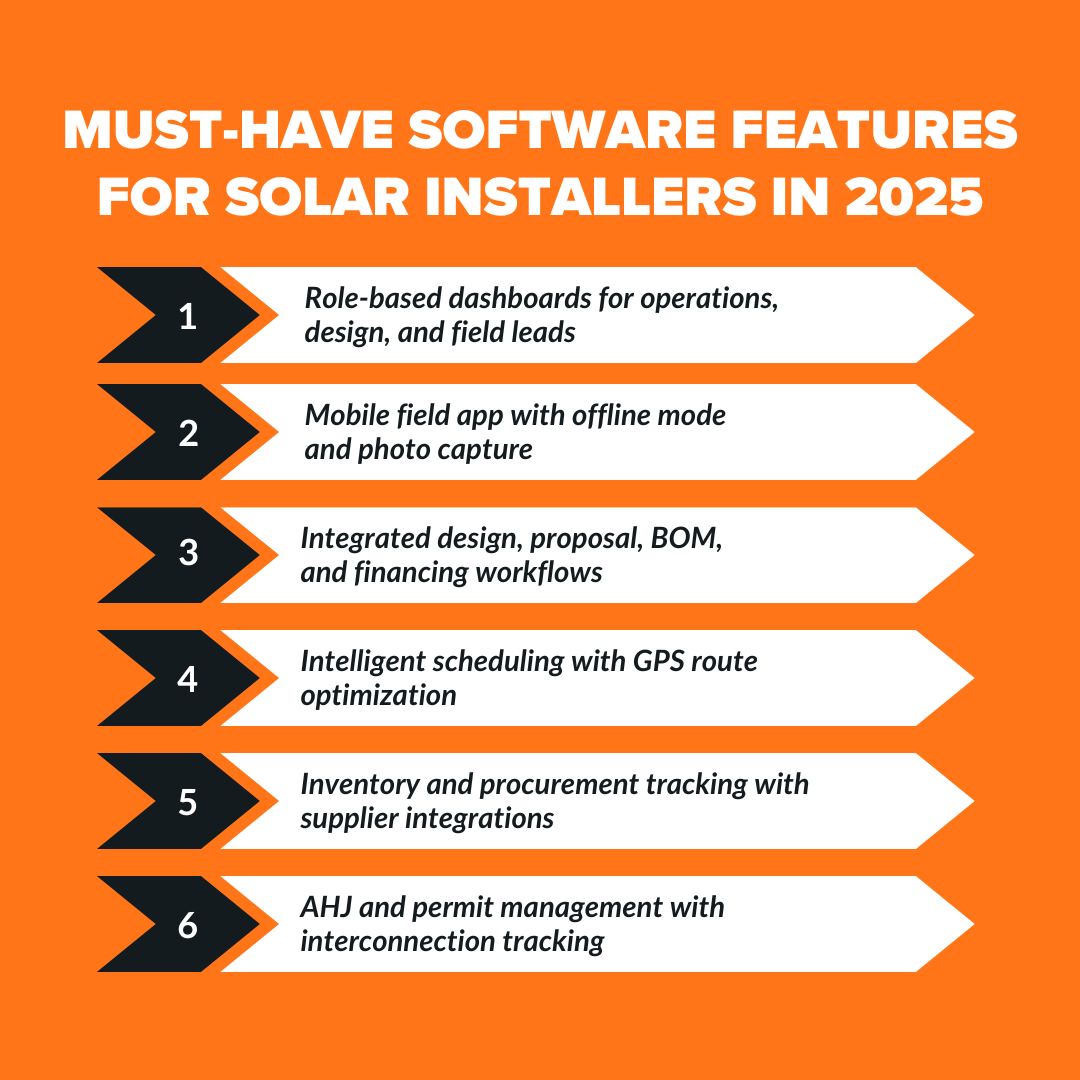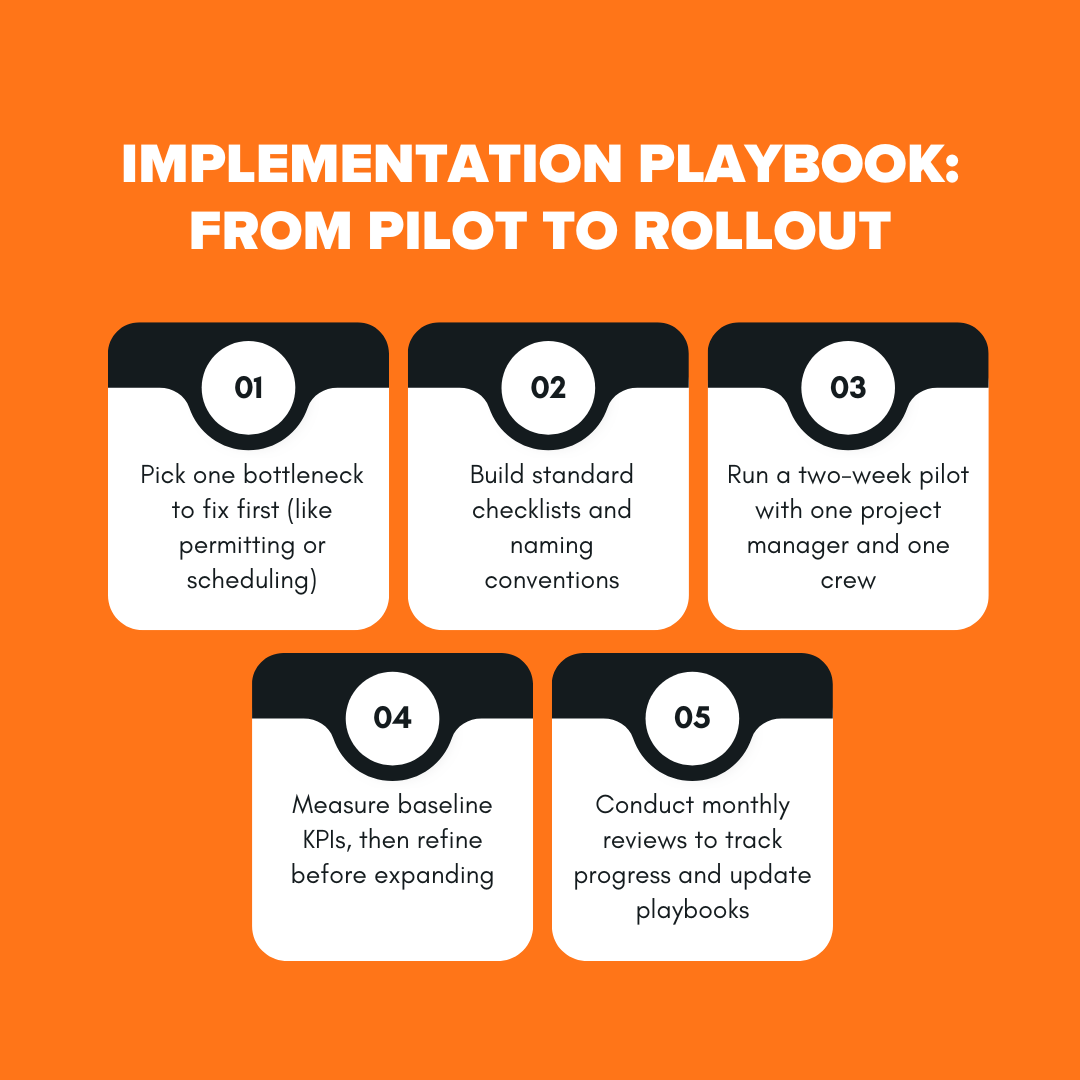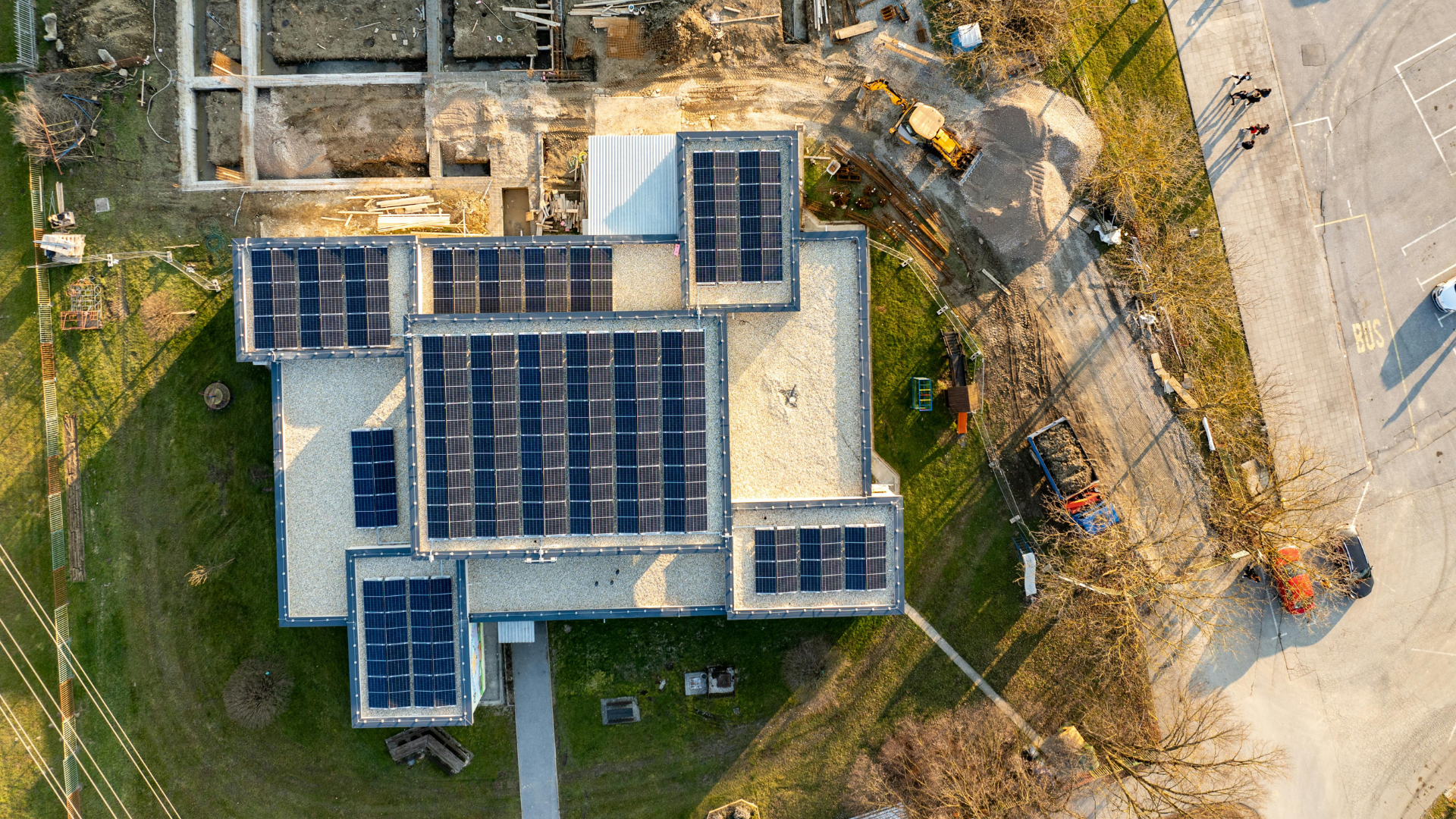October 13, 2025
Audio overview: Listen & Learn
2025 is shaping up to be a tough but thrilling year for the solar industry and its installers. Demand is all over the place, permits drag on, parts frequently go missing, and customers want instant updates every step of the way.
All this is a huge challenge when crews are already at capacity and schedules are extremely tight, especially considering the upfront cost of projects.
But the good news is that the right software can ease all this chaos. With improved design tools, smarter scheduling, more efficient permit workflows, and transparent customer updates, teams can keep projects on track and protect margins.
In this guide, we’ll discuss the five biggest challenges for solar installers and demonstrate practical ways software helps.
Biggest Challenges Facing Solar Installers in 2025 - And How the Right Software Solves Them
If you’ve been in solar for a while, you know every year brings new challenges, but 2025 feels different.
Installations are booming, crews are stretched thin, and the pressure to deliver clean energy on time and within budget is heavier than ever.
Besides all this, installers are juggling tighter margins, stricter codes, demanding customers, and shifting policies, all while navigating supply hiccups.
This simply indicates that the solar industry is still growing fast, with big opportunities ahead, but the pace comes with real challenges. The trick is learning how to adapt quickly without cutting corners.
This guide breaks down five major hurdles installers face this year and shows how the right software can simplify work, prevent mistakes, and give your team a real edge.
By the end, you’ll have a practical roadmap to keep projects on track, even as the market gets more demanding.
Key Takeaways
- Solar installation success depends as much on operational efficiency as on technical skill.
- Permitting, scheduling, and inventory challenges can quietly derail projects if overlooked.
- Modern software tools can transform chaos into predictable, streamlined operations, but only if chosen wisely.
- Small design errors often snowball into major delays and extra costs.
The Solar Installation Survival Guide: Conquering the 5 Operational Challenges That Make or Break Contractors

Solar installation success is about both the technical expertise and mastering the operational chaos that can turn profitable projects into costly nightmares.
From permit delays that stretch for weeks to government policies and supply chain snags that leave crews idle, these five critical challenges separate thriving solar contractors from those barely staying afloat:
1. Permits, AHJs, and Red Tape: Control the Chaos Before It Disrupts Your Schedule
Imagine this: your crew is ready to start installing solar panels and battery storage on a customer’s roof, but the permit hasn’t come through. Days stretch into weeks, and the customer starts calling every morning. Suddenly, with the upfront cost looming, what should have been a smooth solar PV installation turns into a frustrating delay.
1.1 The problem
Every Authority Having Jurisdiction (AHJ) has its own rules. One city might require special electrical system diagrams, while another demands structural reports.
Add in NEC compliance, fire setbacks, interconnection delays with utility companies, and you’ve got a maze of paperwork. Permit backlogs, resubmissions, and failed inspections can also derail entire solar projects.
1.2 Impact on teams
When operations start to slip, the ripple effect can be bigger than you think. From frustrated teams to unhappy customers, here’s how the cracks really show up in your business.
- Impact on teams: When processes aren’t smooth, your team ends up stressed and less productive.
- Rework and wasted hours: Simple mistakes often turn into hours of extra work that could have been avoided.
- Slipped project timelines: Deadlines start dropping, which throws off the entire schedule.
- Decreased profit margins: More time and resources wasted means less money in your pocket at the end of the day.
- Frustrated customers who may walk away or leave negative reviews: And when clients feel let down, they’re quick to take their business elsewhere or leave bad reviews that hurt future sales.
1.3 How software solves it
Permits and approvals are among the biggest bottlenecks in any project, often delaying everything before the actual work even starts.
The good news? With the right software, you can bypass the red tape and keep projects on track without the constant headaches.
- AHJ rules database by ZIP code or municipality: Instead of chasing down local codes, you can instantly see the exact requirements for any area before you even start.
- Digital permit packages with smart forms, e-signature, and submission trackers: No more stacks of paperwork; everything gets filled, signed, and tracked online in one place.
- Auto-flagging of code conflicts before submittal: The system catches errors or missing details ahead of time, so you don’t waste weeks waiting on rejections.
- Utility interconnection workflows with real-time status updates: You can follow approvals step by step, eliminating the guesswork and reducing the need for endless back-and-forth with utilities.
1.4 KPIs to watch
Measuring the correct numbers keeps your projects running smoothly and shows you exactly where improvements can be made. Here are a few KPIs that give real insight into your permitting process and align with your energy needs .
- First-pass permit approval rate: A higher approval rate on the first try means fewer revisions and faster project starts.
- Days-to-permit: Tracking how long it takes to secure permits reveals where delays are consuming valuable time.
- Failed inspection rate: Fewer failed inspections keep your projects on schedule and your clients confident in your work.
If you don't understand the need for Solar CRM, then take a look at this: Why Solar Businesses are switching from Excel to Sunbase
2. Design Misses and Costly Change Orders: Fix Problems Before You’re on the Roof
Ask any solar installer, and they’ll tell you: nothing stings more than climbing up on the roof, opening the boxes of solar panels, only to realize the design doesn’t match the site conditions. Suddenly, you’re scrambling to change the system design while the clock is ticking.
2.1 The problem
Designing a solar project and evaluating business models may seem straightforward on paper, but even small mistakes in the early stages can quickly escalate. Here are the common problems that slow projects down and eat into profits.
- Inaccurate site data: Bad measurements at the start can throw off the entire design, leading to costly corrections later.
- Shading surprises or roof obstructions: Missed trees, chimneys, or vents often pop up mid-project, forcing unexpected redesigns.
- Manual takeoffs leading to mismatched bills of materials (BOMs): Manual calculations leave plenty of room for errors, which means the materials ordered don’t always match what’s actually needed.
- Last-minute edits when the system components don’t align: When panels, inverters, or racking don’t fit together as planned, you end up scrambling to fix issues right before installation.
2.2 Impact on teams
When errors start to add up, their impact extends to multiple projects. They drain budgets, slow down progress, and damage client trust, ultimately affecting every corner of your business.
- Expensive change orders: Every change order incurs unexpected costs that erode your margins.
- Returns and wasted parts: Ordering the wrong materials leads to increased returns, wasted parts, and unnecessary expenses.
- Delayed solar installations: Missed details can push projects back, leaving crews idle and schedules backed up.
- Customers doubting your professionalism: When things keep going wrong, clients start questioning whether they made the correct choice in selecting the installer.
2.3 How software solves it
The right software eliminates the guesswork from solar system design, ensuring projects run smoothly. With the latest solar technologies and more innovative tools, you can cut down errors, save time, and deliver a better experience for your customers.
- Integrated design tools with LIDAR, aerial imagery, tilt, azimuth, and shade modeling: You get accurate site data upfront, so designs are precise and problems are spotted before installation begins.
- Auto-generated BOMs are tied to the design with SKU-level pricing: Materials are calculated automatically with exact pricing, ensuring no mismatches between the plan and the order.
- Mobile capture tools for roof photos, conduit routes, and as-built notes: Field teams can upload pictures and notes directly from the site, keeping everything synced in one place.
2.4 KPIs to watch
Monitoring appropriate metrics enables early identification of bottlenecks and ensures the progress of projects without unforeseen issues. Here are several KPIs that demonstrate the effectiveness of your design process.
- Design-to-install cycle time: Shorter timelines mean your projects are turning around faster and cash is flowing in sooner.
- Change order frequency: Fewer change orders show your designs are accurate and your team isn’t wasting time fixing mistakes.
- Design accuracy rate: A higher number here shows that your planned designs align closely with what’s actually built, boosting accuracy and project reliability.
3. Crew Scheduling Mayhem: Get the Right Team to the Right Roof, On Time
Picture this: two crews show up at the same site while another sits idle because of a scheduling slip. Or worse, your most experienced electrician is assigned to a job that only requires basic mounting, while a crew with no electrical certifications ends up stuck on a complex install.
3.1 The problem
At first glance, scheduling appears easy, but it’s often where operations start to unravel. Overlapping crew assignments, unforeseen weather changes, and poor planning can all snowball into delays that throw entire projects off track.
- Double booking: When crews get scheduled for two jobs at once, it creates chaos and leaves someone disappointed.
- Excessive travel and idle time: Poor planning means teams spend more time on the road or waiting than actually working.
- Mismatch of crew skills and job requirements: Sending the wrong crew to the wrong job leads to slow progress and costly mistakes.
- Weather-related delays with no backup plan: A rainy day or sudden storm can halt everything if there’s no contingency plan in place.
3.2 Impact on teams
When scheduling breaks down, it affects multiple things, like the calendar, which takes a hit, your people, profits, and customer relationships, all of which feel the strain. The impact runs deeper than most teams realize.
- Longer project timelines: Delays pile up, stretching projects far beyond what was promised.
- Overtime costs and burned-out employees: Crews end up working longer hours, driving up labor costs and draining morale.
- Unhappy customers and missed service windows: Clients lose patience when commitments aren’t met, and trust quickly erodes.
3.3 How software solves it
Good scheduling software ensures the right crew is assigned to each job at the right time. It minimizes delays, keeps projects on track, and helps maintain smooth operations while keeping customers satisfied.
- Smart scheduling that matches crew skills and certifications to the right job: The system makes sure every job is assigned to the crew that’s actually qualified to do it right the first time.
- Route optimization with GPS and geofencing for accurate arrival times: Crews spend less time stuck in traffic and more time completing the job, with accurate ETAs for customers.
- Subcontractor portals with job packs, checklists, and milestones: Subs stay on track with everything they need in one place, reducing confusion and missed steps.
- Drag-and-drop calendar sync that adjusts for weather changes: When the weather turns, schedules update instantly so projects keep moving without a scramble.
3.4 KPIs to watch
Numbers don’t lie, and the right ones can tell you exactly how efficient your scheduling is. Keep an eye on these KPIs, along with your financial resources, to identify areas for improvement before they hinder your progress.
- Jobs completed per crew per week: A higher number shows your teams are working efficiently and schedules are on point.
- Average travel time: Tracking how long crews spend on the road highlights if routes are wasting more time than they should.
- On-time arrival rate: The closer this is to 100%, the more reliable your team looks in the eyes of customers.
33% of solar installers report that permitting and interconnection rules are their most significant barrier to success, with delays often extending project timelines by weeks or months.
4. Parts Shortages and Logistics Snags: Keep Panels, Inverters, and Vans Moving
The supply chain for solar panel manufacturing and system components has been rocky in recent years. In 2025, the solar market is still reeling from the ripple effects of global shortages, fluctuating demand, and the introduction of new technologies, including battery storage.
4.1 The problem
Inventory might not be the flashiest part of solar operations, but when it goes wrong, everything else grinds to a halt. Here are the common supply headaches that cost teams time and money.
- Panel and inverter shortages: When key components aren’t available, projects stall before they even get started.
- Wrong SKUs or missing equipment: Simple ordering mistakes can leave crews stranded on-site without what they need.
- Warehouse disorganization: A messy warehouse means hours wasted searching for parts instead of installing them.
- Unknown van stock and manual purchase orders: Without visibility into what’s on each truck, duplicate orders pile up and materials slip through the cracks.
4.2 Impact on teams
When inventory slips through the cracks, the ripple effects are felt by both your crews and your bottom line. The costs show up in ways that go far beyond just missing parts.
- Delayed installations: Projects get pushed back while teams wait around for equipment to arrive.
- Costly re-visits when the right parts aren’t available: Crews have to return to the same site twice, doubling labor costs and wasting time.
- Lost revenue streams from project delays: Every postponed job means cash flow slows down and growth takes a hit.
4.3 How software solves it
Modern inventory tools ensure the right parts are in the right place when you need them. By streamlining tracking and using smarter systems, they turn supply chain challenges into smooth, predictable workflows.
- Real-time inventory tracking by warehouse and van with barcode or RFID: You always know exactly what’s on the shelf or in each truck, so nothing goes missing.
- Automated purchase orders tied to pipeline demand forecasts: The system predicts what you’ll need and orders it ahead of time, cutting down on shortages.
- BOM-to-picklist automation to ensure the correct parts are pulled: Materials are pulled directly from the design, so crews leave with the right gear every time.
- Substitution rules for alternate compatible components: If a part is out of stock, the software suggests approved alternatives to prevent project stalls.
4.4 KPIs to watch
Inventory and scheduling can feel under control until the numbers tell a different story. Keeping an eye on these KPIs helps you catch hidden inefficiencies before they drag down performance.
- First-time install completion rate: The higher this rate, the more often crews finish the job in one visit without missing parts.
- Days to install after permit approval: This metric indicates how quickly you can convert approvals into on-site progress.
- Stockout rate: Tracking how often you run out of critical parts reveals whether your inventory system is truly effective or merely holding you back.
5. Lost Docs and Silent Customers: Standardize QA and Communicate Like Pros
It doesn’t matter how flawless the solar energy system design is if the customer feels left in the dark. Misplaced documents, incomplete QA checklists, and scattered text messages can quickly turn a satisfied homeowner into a cancellation.
5.1 The problem
Even the best installation can look sloppy if the details aren’t documented or shared. Gaps in communication and record-keeping often cause issues long after the panels are in place.
- Lost installation photos or wiring diagrams: When key records go missing, troubleshooting and inspections become a nightmare.
- Incomplete QA forms: Skipping or rushing through quality checks leaves room for errors that could have been avoided.
- Lack of proactive customer communication: Clients are left in the dark, leading to frustration and avoidable support calls.
5.2 Impact on teams
When documentation and communication slip, the fallout shows up quickly. What feels like a small miss in the moment can snowball into costly setbacks for your team.
- Failed inspections: Missing details or poor records can cause inspection failures that delay project sign-offs.
- Extra service tickets: Crews end up going back to fix problems that could have been prevented with better documentation.
- Negative reviews and lost referrals: Customers share their frustration, hurting your reputation and future business opportunities.
5.3 How software solves it
Strong software keeps everyone on the same page, from field crews to customers waiting for updates. With the right tools, nothing slips through the cracks, and every handoff feels seamless.
- Centralized job-level document hub with all photos, diagrams, and warranties: Every detail is stored in one place, so teams and customers can access what they need instantly.
- Standardized QA checklists requiring photo proof for completion: Crews can’t close out a task without proof, ensuring quality standards are always met.
- Customer portal with live updates, milestones, and SMS alerts: Clients stay in the loop with real-time progress updates instead of chasing your team for answers.
- Automated handoff of manuals, warranties, and referral prompts post-install: Customers receive everything they need after the job wraps up, turning installs into long-term trust and referral opportunities.
5.4 KPIs to watch
Tracking these KPIs helps you spot issues early and prove your installs are delivering on promises.
- Inspection pass rate: A high pass rate indicates that your installations meet standards the first time, eliminating costly rework.
- Net Promoter Score (NPS): This metric measures the likelihood of customers recommending your brand, directly reflecting their trust and overall satisfaction.
- Customer ticket volume per installation: Fewer support tickets per project indicate that your installations are smooth and your documentation is effective.
Don't be confused when choosing your Solar CRM; just go through this guide and pick the right one Wisely Sales CRM Features Every Solar Company Needs in 2025
Must-Have Software Features for Solar Installers in 2025

When evaluating solar business software, look for tools that actually simplify life instead of adding clutter. The must-haves include:
1. Role-based dashboards for operations, design, and field leads
Give each team exactly what they need to stay focused, without drowning in irrelevant data.
Operations managers see project progress and bottlenecks in real time, designers track plan reviews and
revisions, and field leads monitor crew assignments and job-site updates, all from tailored views that cut through the noise and speed up decision-making.
2. Mobile field app with offline mode and photo capture
Enable crews to work smoothly on-site, even when cell service is unavailable.
Through this feature, technicians can view installation steps, upload photos, update job statuses, and log progress offline, with data syncing automatically once connectivity is restored.
This ensures nothing stalls due to patchy networks and provides a complete visual record of field work.
3. Integrated design, proposal, BOM, and financing workflows
Streamline the entire sales-to-install journey to ensure nothing slips through the cracks.
This means that, from creating detailed system designs and accurate bills of materials to generating professional proposals and financing options, everything flows seamlessly in one platform.
4. Intelligent scheduling with GPS route optimization
Cut wasted driving time and complete more jobs in fewer hours. Automatically assign crews based on location, skill set, and availability, while optimized routes reduce fuel costs and travel time.
Real-time updates keep teams informed of schedule changes, which also ensures maximum productivity and on-time project delivery.
5. Inventory and procurement tracking with supplier integrations
Know what’s in stock, what’s on order, and what’s missing before it causes delays. Real-time inventory visibility across warehouses and trucks ensures you never run out of critical components.
On the other hand, automatic purchase order generation and supplier integration help you restock efficiently and avoid last-minute supply chain disruptions.
6. AHJ and permit management with interconnection tracking
Keep permits, approvals, and utility paperwork moving without bottlenecks. Track every step of the permitting and interconnection process, get alerts on pending actions, and maintain organized records for compliance.
78% of solar installers expect to sell more solar in 2025 than they did in 2024, despite facing significant challenges, including customer acquisition costs and financing obstacles.
How to Choose the Right Platform

Picking solar software isn’t about grabbing the shiniest tool on the shelf. It’s about finding a platform that actually fits how your business runs day to day.
- Aligning with team size and crew structure: Make sure the software works just as well for a small crew as it does for a multi-team operation.
- Factoring in residential vs. commercial solar projects: Choose a platform that can handle the unique demands of the projects you take on most.
- Considering single-region vs. multi-state operations: Look for tools that scale with your geographic footprint, whether you’re local or expanding across states.
- Checking integration needs: design tools, financiers, suppliers, CRMs: The best software should plug right into the tools and partners you already rely on.
- Ensuring compliance with local building codes and security standards: Pick a system that keeps you on the right side of regulations and protects sensitive data.
Implementation Playbook: From Pilot to Rollout

Rolling out new software is about flipping a switch and creating a system that works for your crews. Start small and test different business models.
- Pick one bottleneck to fix first (like permitting or scheduling): Focus on a single pain point to prove the software’s value before tackling everything at once.
- Build standard checklists and naming conventions: Keep things organized so everyone speaks the same language when using the new system.
- Run a two-week pilot with one project manager and one crew: Test on a small scale to work out kinks and gather real feedback from the field.
- Measure baseline KPIs, then refine before expanding: Compare results with your starting point so you know what’s improving and where to adjust.
- Conduct monthly reviews to track progress and update playbooks: Keep fine-tuning your process so adoption improves over time instead of stalling.
Conclusion
The solar energy industry in 2025 is poised for significant growth and opportunity. Solar energy continues to rise as a clean energy leader, fueled by government incentives, tax credit programs, net metering policies, and the drive for a sustainable future.
However, with opportunity comes complexity, whether it’s navigating local codes, managing project delays, or maintaining a steady cash flow.
So what's good here? Solar technology and project management tools are advancing right alongside these challenges. With the right platform, solar installers can streamline operations, enhance customer
communication, and maintain power purchase agreements while providing top-quality solar panel installations.
So, software is no longer a luxury in the renewable energy sector. For modern solar companies, it’s the operating system that addresses the regulatory landscape, environmental concerns, and enables rapid growth to be manageable, profitable, and sustainable.
Ready to take control of your solar projects with Sunbase?
Start small, scale smart, and put the right tools in place to keep your crews moving and your customers happy.
Schedule your demo today and discover how your business can grow and thrive with our solutions!
FAQs:
1. How does changing government policies affect solar installers in 2025?
Government incentives and shifting regulations can either accelerate or slow down installations, so staying updated is crucial for long-term planning.
2. What role does market saturation play in solar sales today?
With more solar providers entering the market, competition is intensifying, making differentiation and service quality in renewable energy jobs more important than ever in terms of efficiency.
3. Why is the environmental impact of solar projects still a hot topic?
Beyond clean energy production, questions around panel recycling and supply chain practices are shaping how customers view solar companies.
4. What are the most common challenges solar companies face in scaling operations?
From navigating policies to handling saturated markets and maintaining eco-friendly practices, growth often comes with multiple hurdles to solve.
I agree to receive marketing messaging from Sunbase at the phone number provided above. I understand data rates will apply, and can reply STOP to OPT OUT.







